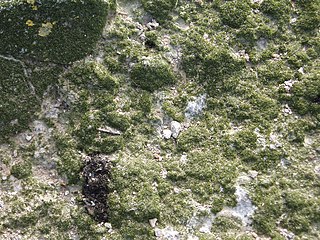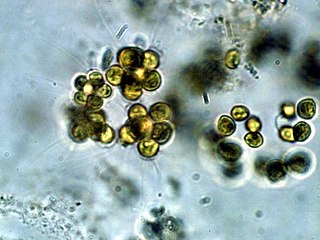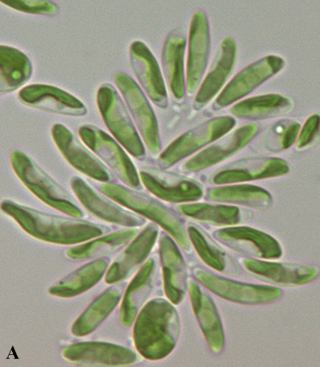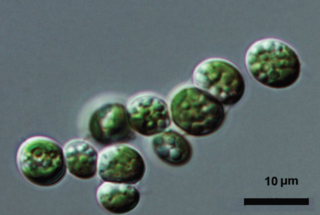
The aggregating anemone, or clonal anemone, is the most abundant species of sea anemone found on rocky, tide swept shores along the Pacific coast of North America. This cnidarian hosts endosymbiotic algae called zooxanthellae that contribute substantially to primary productivity in the intertidal zone. The aggregating anemone has become a model organism for the study of temperate cnidarian-algal symbioses. They are most well known for the ability to clone themselves.
Zoochlorella is a colloquial term for any green algae that lives symbiotically within the body of an aquatic invertebrate animal or a protozoan.

The Trebouxiophyceae, also known as trebouxiophytes, are a class of green algae, in the division Chlorophyta. Members of this class are single-celled, colonial, or multicellular and are found in freshwater or terrestrial habitats worldwide. Many taxa in the Trebouxiophyceae form symbiotic relationships with other organisms; in particular, the majority of phycobionts within lichens are trebouxiophytes. A number of taxa have also lost the ability to photosynthesize, and have evolved to become parasitic; examples include Prototheca and Helicosporidium.

Prasiolales is an order of green algae in the class Trebouxiophyceae. Members of this order are ecologically widespread and are found in freshwater, marine, and terrestrial habitats from the Arctic to the Antarctic.

Botryococcaceae is a family of green algae in the class Trebouxiophyceae.

Prasiolaceae is a family of green algae in the order Prasiolales. Members of this family are found in freshwater, terrestrial, and marine habitats.

Selenastraceae is a family of green algae in the order Sphaeropleales. Members of this family are common components of the phytoplankton in freshwater habitats worldwide. A few species have been found in brackish and marine habitats, such as in the Baltic Sea.
Desmococcus is a genus of green algae in the family Stichococcaceae. It is a subaerial genus of algae with a cosmopolitan distribution.
Dictyochloropsis is a genus of unicellular green alga of the phylum Chlorophyta. This genus consists of free-living algae which have a reticulate (net-like) chloroplast that varies slightly in morphology between species, and that when mature always lacks a pyrenoid. Dictyochloropsis is asexual and reproduces using autospores.

Dictyosphaerium is a genus of green algae, in the family Chlorellaceae. It occurs in freshwater habitats around the world and is planktonic. The name comes from the Greek roots diktyon, meaning "net", and sphaira, meaning "ball", referring to its morphology.

Lagerheimia is a genus of green algae in the family Oocystaceae. It is commonly found in freshwater habitats all over the world, although some species are rare and have only been recorded from Europe or the United States.

Micractinium is a genus of green algae in the family Chlorellaceae. Species of the genus Micractinium are common in freshwater habitats. A few species are found as endosymbionts of protozoa, such as Micractinium conductrix and Micractinium tetrahymenae.

Paulschulzia is a genus of green algae, specifically of the family Tetrasporaceae.

Stichococcus is a genus of green algae in the family Stichococcaceae. It is a very common algal genus found in a variety of habitats, such as tree trunks, soil, snow, freshwater and marine habitats. One species, Stichococcus bacillaris is economically important as it produces fatty acids useful for biofuels.

Trebouxia is a unicellular green alga. It is a photosynthetic organism that can exist in almost all habitats found in polar, tropical, and temperate regions. It can either exist in a symbiotic relationship with fungi in the form of lichen or it can survive independently as a free-living organism alone or in colonies. Trebouxia is the most common photobiont in extant lichens. It is a primary producer of marine, freshwater and terrestrial ecosystems. It uses carotenoids and chlorophyll a and b to harvest energy from the sun and provide nutrients to various animals and insects.

Crucigenia is a genus of green algae in the class Trebouxiophyceae. It is widespread, but not often abundant, in freshwater habitats around the world.

Coccomyxa is a genus of green algae in the family Coccomyxaceae. This genus is defined by their small, elliptical to spherical shape, and the presence of a simple parietal chloroplast. These features, along with their occurrence in various lifestyles such as free-living, parasitic, or as photobionts, have been used to identify more than 40 species. Using additional morphological features, such as brown akinetes formation, allows for the differentiation between Coccomyxa and the genus Pseudococcomyxa, as they tend to share some morphological characteristics like the general cell shape and one-sided mucilage cap. Recent molecular analysis, however, indicates that the genus Pseudococcomyxa is contained within different Coccomyxa clades, signaling the fact that the two genera are the same. Coccomyxa has often been used as a model organism, and its genome is being completely sequenced. The genus is also an attractive candidate for biofuels.
Symbiochloris reticulata is a species of green alga in the Trebouxiales. It is a known as a photobiont with several lichen species, like Lobaria pulmonaria, but also as a free-living soil alga as well. Phylogenetic analysis of rRNA sequence data revealed that the species shares a sister group relationship with two other green algae that lack motile stages, Chlorella saccharophila and C. luteoviridis.
Asterochloris is a genus of green algae in the family Trebouxiophyceae. It is a common photobiont in lichen, occurring in the thalli of more than 20 lichen genera worldwide. Asterochloris is distinguishable from the morphologically similar genus Trebouxia, primarily due to its deeply lobed chloroplast, the placement of the chloroplast along the cell's periphery before the initiation of zoospore or aplanospore formation, and its tendency to primarily reproduce asexually through the production of aplanospores.

Elliptochloris bilobata is a species of green alga in the order Prasiolales. First described in 1980, it is the type species of the genus Elliptochloris. The microscopic alga has distinctive ellipsoid cells containing a unique bilobed chloroplast, and reproduces both through autospores and rod-shaped spores. Though originally discovered as a photobiont within the lichen Catolechia wahlenbergii in the Austrian Alps, it has since been found living freely across Europe, Israel, and Antarctica. The species grows on various surfaces including soil, rock, and tree bark, and is known for its ability to grow in both natural and human-modified environments.














